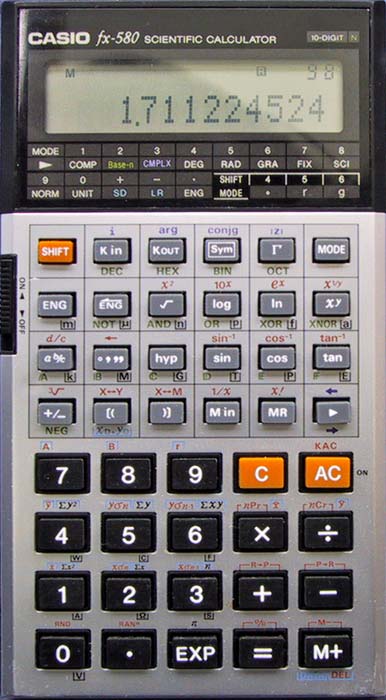casio fx-580
| a very stylish and competent scientific model similar
in design to the fx-3800p. this model is not programmable, but offers more in terms of scientific functions than others in this series. it is algebraic entry, rather than formula like the fx-4000p and fx-5000f and has a dot matrix display useful for the advanced features. along with the usual scientific function here are fractions, 2d statistics with linear regression, number bases, complex numbers, physics units and magnitudes and the gamma function. complex numbersthese are done fairly well. in complex mode, there are buttons for i, arg(z), cong(z) and |z| which are all handy. the longer dot matrix display is better for complex numbers since you can see the start of any complex part in the answer (eg 1.098684113+0...) to see more, there is a scroll left and right button. the complex number coverage is fair but not complete; you have sqrt, 1/x, x2, xy, cube root, as well as the usual arithmetic. none of the scientific operations work with complex numbers and return an error. still more than the fx-5500l but nowhere as capable as the hp15c. statisticshere are the usual 2d stats offering from casio. using the kout memories to return the partial sums, there is also linear regression and interpolation. physics units and magnitudesthis must have seemed like a good idea but it doesn't really add much in way of true usefulness. in any mode you can use the magnitudes k, M, G, T, P & E which are shorthand for 10^3 thru 10^18 and the corresponding m, u, n, p, f & a which represent 10^-3 thu 10^-18. the units are also the symbols W, C, F, A, Ω, S & V. the latter are only available in units mode and correspond to the physical dimensions, watts, coulombs, farads, amps, ohms, seconds and volts. for example 2A*3V = 6W, so it knows simple relationships between them. this would have been much more useful if a more compete set of units were present, for example where is length or force? nevertheless this might be of use occasionally, although i would gladly swap this feature for built in physical constants like the fx-570 number basesthese are the usual casio offering with a 32 bit hex wordsize and bases decimal, hex, octal and binary on offer. in bases mode, there are dedicated keys for a-f and also several binary operations; not, and, or, xor, xnor and neg (wot no nand?). these all work well. the binary wordsize is 12 bits (signed) so it is more limited than the other modes and wont scroll. gamma functiona bit of a surprise to find the gamma function, Γ, on a key of its own. there it is. for example, Γ(70.9) = 7.827382824e99. apart from the advanced hps (eg hp15c, hp48g), its rare to have this on a non-programmable. for instance the quirky commodore sr-9190 has ln(gamma(x)). |
 |